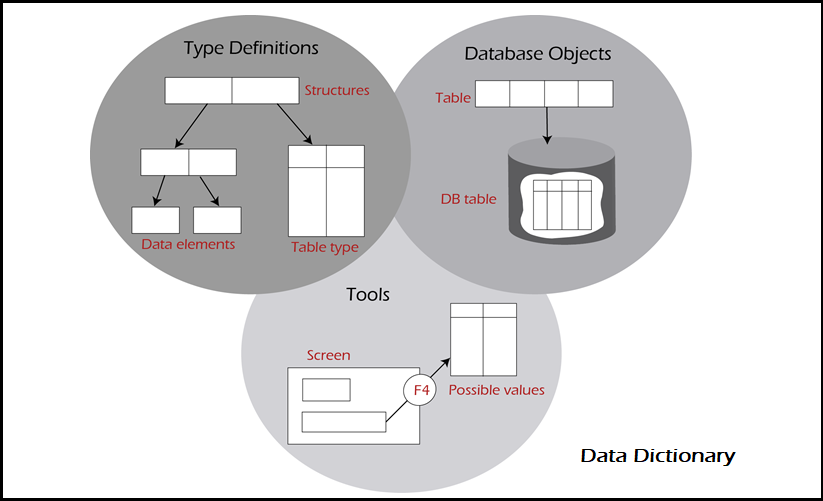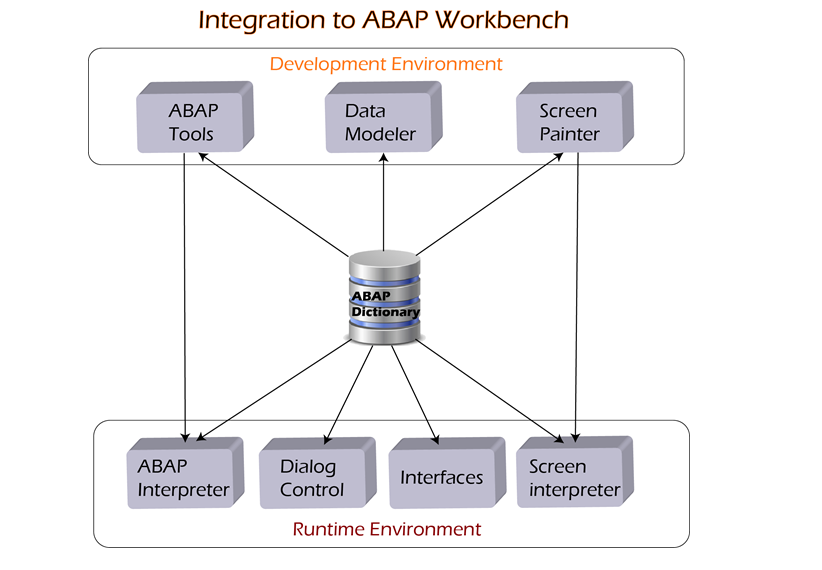SAP ABAP Data Dictionary
Data dictionary is a centralized repository with the information about the data in the information system. Its main objective is to provide the information about the data such as meaning, relationships to other data, origin, usage and format.
Data definitions (metadata) can be created and managed in ABAP dictionary. ABAP data dictionary permits the system components to use the centralised data description. All the information (either new or modified) shared automatically to the system components.
The advantages of data dictionary are data integrity, data consistency and data security. Below diagram explains data dictionary in detail -

ABAP Data Dictionary Object Types -
ABAP data dictionary supports below user defined data types (Data elements, Structures and Table types). ABAP data dictionary also supports the database objects (Tables, Indexes and Views).
The most important object types in ABAP data dictionary are -
| Object name | Description |
|---|---|
| Tables | Table is a logical structure for storing data. Table is the set of rows and columns that are logically related.
Table can be defined independent of the database in ABAP dictionary. The table fields are defined with the database independent elementary data types and lengths. The physical table definition created in the database when the actual table activated in the data dictionary. |
| Views | View is a logical representation of summarized data from two or more tables. The view structure can be defined by specifying table names and required field names from the joined tables. View is not stored physically. ABAP supports different view types like database views, projection views, help views and maintenance views. |
| Types | Specifies the user defined data types stored in ABAP dictionary. These types stored in ABAP dictionary and available for all the programs. There are three predefined Types in ABAP dictionary and those are -
|
| Domains | Specifies the technical characteristics of a table field. Domain assigned to a data element and defines a value range. Any value of the table field that linked to a data element range also defines by a domain. Fields or components that assigned to a same domain gets changed if domain changed. |
| Search helps | Search help is a tool to search for the data records in the system. The input help(F4) is a standard function for search help in R/3 system. The user can display the field possible values list with search help. Search help can categorise into two types and those are - elementary search help and collective search helps. |
| Lock Objects | Lock mechanism allows simultaneous accessing of same data records by two or more users at the same time. Functional Modules are responsible for set and release the locks. Function modules are automatically generated from the lock objects definition in the ABAP/4 Dictionary. |
Integration to ABAP Workbench -
ABAP Data dictionary completely integrated to ABAP workbench. ABAP system allows the Data dictionary to be integrated actively with development environment.
Below diagram shows the integration to ABAP/4 workbench -

Objects may have both active and inactive components at the same time in ABAP dictionary. Objects of ABAP dictionary changed any number of times before activating and available to the all components of the system. Inactive objects have no impact on the system and uses for modifications.
Related Transactions -
- SE11 - Data Dictionary Initial Screen
- SE12 - Data Dictionary Initial Screen Display only
- SE13 - ABAP Dictionary Technical Settings
- SE14 - Database Utility
- SE15 - Repository Information System
- SE16 - Data Browser
- SE17 - General table Display
- SE55 - Table View Maintenance
- SM30 - Table Maintenance
